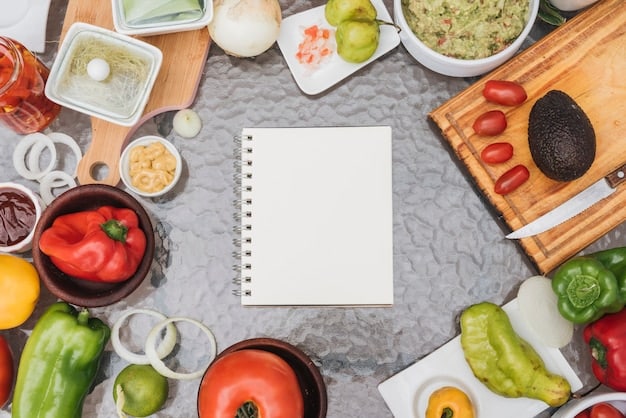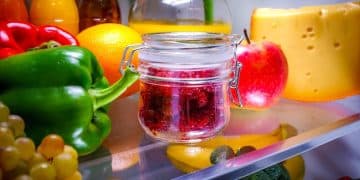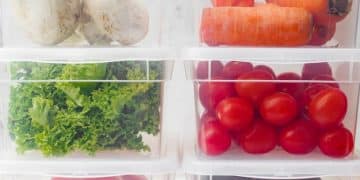Beyond Coupons: Creative Grocery Saving Strategies You Haven’t Tried Yet

For households seeking real financial relief and a more sustainable approach to food, exploring grocery saving techniques beyond traditional coupons, such as strategic meal planning, embracing bulk purchases, and reducing food waste, offers substantial, long-term benefits to your budget and lifestyle.
In an era where every penny counts, mastering the art of grocery savings is more crucial than ever. While coupons have long been a go-to strategy, they often represent just the tip of the iceberg when it comes to truly impactful financial adjustments. This article delves into creative, less-explored methods designed to help you save significantly on your grocery bills, extending beyond coupons: creative ways to save on groceries you haven’t tried yet.
Mastering the Strategic Meal Plan
Effective meal planning is arguably one of the most powerful and often underestimated tools in your grocery savings arsenal. It goes beyond simply deciding what to eat each week; it involves a thoughtful, strategic approach to consumption that minimizes waste and maximizes your budget.
The Art of Inventory-First Planning
Before you even think about what new recipes to try, start with what you already have. This “inventory-first” approach ensures you use up ingredients before they expire, reducing immediate waste and informing your shopping list. Look into your pantry, fridge, and freezer with a critical eye, noting items that need to be consumed soon.
- Regular Pantry Audits: Make it a weekly habit to check expiration dates and identify ingredients that can be incorporated into upcoming meals. This prevents forgotten items from turning into food waste.
- Freezer Stock-Take: Understand what meats, vegetables, and pre-cooked meals you have stored. Thawing and using these reduces immediate purchase needs and helps circulate your stock.
- Utilize Leftovers Creatively: Plan for leftovers to be transformed into completely new dishes. For instance, roast chicken one day can become chicken tacos or a chicken salad the next.
This systematic review not only saves money but also encourages creativity in the kitchen, challenging you to make the most of every ingredient. It transforms meal planning from a chore into a rewarding puzzle.
Leveraging Seasonal Produce and Sales Cycles
Another cornerstone of savvy meal planning is aligning your meals with seasonal produce and upcoming sales. Seasonal fruits and vegetables are typically less expensive, fresher, and more flavorful because they don’t incur high shipping or storage costs. Being aware of your local grocery store’s sales cycles can also lead to significant savings.
For example, if your store typically has a “buy one, get one free” on certain proteins every second week, you can plan to buy and freeze those items during the sale. Similarly, if berries are in season, integrate them into breakfasts, desserts, and snacks. This proactive planning prevents impulse buys and ensures you’re getting the best value for your money, often yielding higher quality ingredients for less.
Ultimately, strategic meal planning provides a clear roadmap for your grocery shopping, drastically reducing impulse purchases and food waste. It’s an investment of time upfront that pays dividends in savings and culinary creativity throughout the week.
Unconventional Bulk Buying and Storage Solutions
The concept of buying in bulk is not new, but many people don’t fully leverage its potential or consider the less obvious categories where it can lead to substantial savings. Furthermore, having effective storage solutions is paramount to making bulk buying truly economical.

Beyond Dry Goods: Bulk Protein and Dairy
While pasta, rice, and beans are common bulk purchases, consider expanding your horizons to proteins and dairy. Many butcher shops or warehouse clubs offer significant discounts on larger cuts of meat, whole chickens, or family packs of ground beef. Similarly, larger containers of yogurt, cheese, or eggs often present a better unit price.
- Meat Freezing Strategies: When buying large quantities of meat, portion it out immediately upon returning home. Use freezer bags or vacuum sealers to prevent freezer burn, labeling with the date and type of meat. This ensures you can easily grab exactly what you need without thawing an entire package.
- Cheese, Butter, and Dairy: Hard cheeses can be frozen, as can butter. Even milk can be frozen in clean containers, though its texture might change slightly for drinking but remains perfectly suitable for cooking and baking.
- Utilizing Sales Cycles: Keep an eye out for sales on these items. Freezing allows you to take advantage of these fleeting opportunities and stock up when prices are at their lowest.
This approach allows you to secure essential, often more expensive, food items at a lower per-unit cost, creating a buffer against future price increases and reducing the frequency of your shopping trips.
Maximizing Storage: Tools and Techniques
The success of bulk buying hinges on proper storage. Without it, your savings can quickly turn into spoilage and waste. Investing in the right storage containers and understanding preservation techniques is crucial.
Airtight containers for dry goods protect against pests and moisture, preserving freshness much longer than original packaging. For fresh produce, specialized containers or simple techniques like wrapping herbs in damp paper towels can extend shelf life dramatically. Consider a vacuum sealer for meats and some pre-prepped vegetables for freezer longevity.
Furthermore, learning basic canning or dehydrating methods for fruits and vegetables from a local harvest or sale can unlock even greater savings. These preservation techniques, while requiring initial effort, mean you can enjoy seasonal produce year-round at a fraction of the cost, making your bulk buying truly sustainable.
By expanding your bulk buying categories and optimizing your storage methods, you’re not just saving money; you’re building a more resilient and efficient food system for your household, ensuring you always have quality ingredients on hand without overspending.
Harnessing Technology Beyond Coupon Apps
The digital age offers a plethora of tools for saving money on groceries that extend far beyond the typical coupon aggregation apps. Leveraging these technologies creatively can provide insights and opportunities for savings that might otherwise be missed.
Price Tracking and Comparison Websites/Apps
Many consumers still rely on circulars or in-store visits to compare prices. However, dedicated price tracking websites and apps allow you to monitor prices of frequently purchased items across multiple stores over time. This data can reveal patterns of sales, helping you decide the optimal time to buy specific products.
- Historical Price Data: Some apps provide graphs of how a product’s price has fluctuated, allowing you to identify if a current “sale” is truly a good deal or just a typical fluctuation.
- Targeted Alerts: Set up alerts for specific products you buy regularly. When their price drops below a certain threshold at a store near you, you’ll receive a notification, ensuring you never miss a genuine markdown.
- Geographic Comparisons: Compare prices not just between different chains, but also between different locations of the same chain, as prices can vary regionally.
Such tools empower you to be a more informed shopper, moving from reactive coupon clipping to proactive, data-driven savings. It’s like having a personal shopper who knows all the best deals.
Utilizing Store Loyalty Programs and Digital Wallets Wisely
Most grocery stores have loyalty programs, but many shoppers don’t fully optimize them. These programs often offer personalized discounts based on your purchasing history, which can be far more valuable than generic coupons.
Beyond simply scanning your card, actively engage with the digital aspects of these programs. Many offer “clip to card” digital coupons directly through their apps or websites, which are tailored to your buying habits. Some even allow you to earn points towards gas, future discounts, or exclusive member-only deals. Additionally, integrating these loyalty programs with digital wallet apps can streamline the checkout process and ensure you don’t miss out on savings because you forgot your physical card.
Furthermore, several apps and platforms offer cash-back rewards on everyday purchases, including groceries, without requiring traditional coupons. These platforms partner with various retailers, providing opportunities to earn a percentage back on your spending either as cash or gift cards. Linking your credit card to these apps means you’re passively earning rewards on purchases you’d make anyway, adding another layer of savings that transcends the traditional coupon mentality.
By embracing these digital tools, you transform grocery shopping from a simple transaction into a strategic operation, uncovering hidden savings and making every purchase work harder for your budget.
Creative Ways to Reduce Food Waste (Beyond Composting)
Food waste is not just an environmental issue; it’s a significant financial drain on households. While composting addresses the environmental aspect, preventing good food from being wasted in the first place is the ultimate saving strategy.
“Root-to-Stem” and “Nose-to-Tail” Cooking
Embracing a holistic approach to cooking, where you utilize every edible part of an ingredient, can significantly reduce waste. “Root-to-stem” cooking involves using parts of vegetables typically discarded, such as broccoli stems, carrot tops, or beet greens. These often contain just as much, if not more, nutritional value and flavor as the more commonly consumed parts.
- Vegetable Scraps for Broth: Keep a bag in your freezer for vegetable scraps (onion peels, carrot tops, celery ends) to make homemade vegetable broth, a flavorful and economical alternative to store-bought versions.
- Greens Power: From radish greens to beet greens, many “ignored” parts are delicious sautéed or added to smoothies, providing extra nutrition at no additional cost.
- Citrus Zest and Peels: Don’t just throw away citrus peels. Zest them for flavor in cooking or baking, or candy them, or even infuse them in vinegar for an all-natural cleaner.
Similarly, “nose-to-tail” cooking for meats encourages using less popular cuts or bones for stocks and sauces, yielding deeply flavorful bases that elevate simple meals.
Strategic Storage and Revitalization Techniques
Beyond basic refrigeration, understanding food science and having a few tricks up your sleeve can drastically extend the life of your produce and even rescue items on the brink of spoilage.
For example, storing herbs upright in a glass of water on the counter (like flowers) can keep them fresh for days longer than simply putting them in the fridge. Similarly, wrapping leafy greens in a damp paper towel before placing them in a sealed bag helps maintain their crispness. Knowledge of which fruits and vegetables emit ethylene gas (which speeds ripening) and storing them separately is key to avoiding premature spoilage.
For produce that’s gone a bit limp – think celery or greens – a quick ice bath can often revitalize them, making them usable again. Even stale bread can be transformed into croutons, breadcrumbs, or French toast instead of being discarded. These revitalization techniques transform seemingly lost causes into perfectly usable ingredients, saving a last-minute trip to the store and preventing money from going into the trash.
By adopting these creative culinary habits and storage insights, you’re not just preventing waste; you’re maximizing the value of every grocery item, turning potential waste into delicious and economical meals.
DIY Essentials: Making Your Own and Saving Big
The supermarket shelves are lined with convenience items that, while appealing, often come with a significant mark-up. Many of these can be easily and economically made at home, offering substantial savings and often superior quality.
Building a “Basic Pantry” and Baking from Scratch
A well-stocked “basic pantry” is the foundation for making many common grocery items from scratch. Ingredients like flour, sugar, yeast, baking soda, oats, and various spices allow you to bake your own bread, muffins, and cookies. Not only is this often much cheaper per serving, but homemade baked goods avoid many preservatives and artificial ingredients found in store-bought versions.
- Homemade Bread: A loaf of artisan bread can be expensive, but basic ingredients for a homemade loaf are incredibly cheap. Plus, the aroma of fresh bread is unbeatable.
- Granola Bars & Snacks: Store-bought snack bars are pricey and often high in sugar. Making your own allows you to control ingredients and customize flavors for a fraction of the cost.
- Spice Blends: Individual spices are cheaper in bulk, and blending your own allows for custom flavors and avoids fillers often found in pre-made blends.
This principle extends beyond baking. Consider making your own salad dressings, sauces, or even nut milks. The initial effort might seem daunting, but once you have the basic ingredients and a few go-to recipes, it becomes second nature.
Rethinking Convenience: From Broth to Cleaning Supplies
Many everyday convenience items found on grocery shelves have homemade counterparts that are not only significantly cheaper but also often healthier and more eco-friendly. Think about items that contribute heavily to your weekly bill.
For instance, chicken or vegetable broth is a staple in many kitchens. Instead of buying cartons, save chicken bones or vegetable scraps and make your own cost-free, flavor-packed broth. Similarly, simple cleaning solutions can be made from basic pantry staples like vinegar, baking soda, and essential oils, replacing expensive chemical cleaners.
This “DIY essential” mindset transforms grocery shopping. Instead of primarily buying finished products, you’re investing in raw ingredients that can be transformed into a multitude of items. This not only saves money but also fosters a deeper connection to your food and household products, giving you control over quality and ingredients while significantly reducing your overall grocery expenditure.
Mindset Shifts and Shopping Habits for Long-Term Savings
Sustainable grocery savings aren’t just about individual tricks; they require a fundamental shift in mindset and consistent, smart shopping habits. It’s about approaching your grocery run with intention and discipline.
Embracing Imperfect Produce and Outlet Stores
Many consumers are conditioned to seek out perfectly shaped and unblemished fruits and vegetables. However, “ugly” produce is often sold at a significant discount simply due to aesthetic imperfections, despite being perfectly nutritious and delicious. Exploring these options, whether through specialized delivery services or dedicated sections in some grocery stores, can lead to considerable savings.
- Farmers Markets (End of Day): Visit farmers markets towards closing time. Vendors often offer discounts on remaining produce to avoid packing it up, providing fresh, local, and cheaper options.
- Grocery Outlet Stores / Discount Supermarkets: These stores often carry surplus, close-dated, or cosmetically imperfect items from major brands at steeply discounted prices. While selection can be hit-or-miss, regular visits can uncover incredible bargains.
- Community Supported Agriculture (CSAs): While an upfront investment, CSAs provide a weekly share of seasonal, often organic, produce directly from farms, which can be more cost-effective than buying individual items at retail prices over the long term.
This mindset encourages you to look past superficial appearance and recognize value, often leading to fresher, more local produce at a fraction of the cost.
The “Eat Before You Shop” Rule and The List Discipline
One of the oldest and most effective pieces of grocery advice is to never shop on an empty stomach. Hunger leads to impulse buys and an inflated cart. Eating a meal or a hearty snack before you head to the store can significantly curb unnecessary purchases and keep you focused on your list.
And speaking of lists, strict adherence to a pre-planned grocery list is non-negotiable for serious savers. This list, developed from your strategic meal plan and pantry audit, acts as your shopping compass. Avoid browsing aisles aimlessly, as this is where impulse buys thrive. Stick to your list, check items off as you go, and resist the temptation of enticing end-cap displays or “deal” signage that isn’t on your plan.
This discipline transform shopping from a leisurely activity into a focused mission. It requires self-control but empowers you to remain within your budget and avoids the accumulation of items you don’t truly need, cementing a habit of intentional and economical grocery procurement.
Ultimately, these mindset shifts and disciplined habits aren’t just about saving money in the short term; they are about fostering a smarter, more sustainable relationship with food and your finances, ensuring long-term savings.
Community & Bartering: Beyond the Traditional Marketplace
In a world increasingly reliant on commercial transactions, rediscovering community-based strategies for food can unlock unexpected savings and foster a more connected way of living. It’s about tapping into local networks and skills to acquire or share resources.
Gardening and Community Gardens
Growing your own food is arguably the most direct way to save on groceries, particularly for high-cost items like fresh herbs, leafy greens, and certain vegetables. Even a small container garden on a balcony can yield significant savings over time. For those without ample space, community gardens offer plots where individuals can cultivate their own produce, often with shared resources and knowledge.
- High-Value Crops: Focus on growing items that are expensive to buy in stores or those you consume frequently, such as specialty lettuces, tomatoes, peppers, or herbs.
- Seed vs. Seedlings: Starting from seeds is significantly cheaper than buying seedlings, though it requires more time and care.
- Shared Labor/Resources: In a community garden, share tools, knowledge, and even excess produce, maximizing efficiency and minimizing individual costs.
Beyond the financial benefits, gardening offers a rewarding connection to your food source, promoting healthier eating habits and physical activity.
Food Swaps and Bartering Networks
Imagine swapping your excess garden tomatoes for a neighbor’s homemade jam, or trading your baking skills for fresh eggs from a local backyard chicken keeper. Food swap events or informal bartering networks are growing in popularity, enabling individuals to exchange surplus food, homemade goods, or even skills without involving money.
Online community groups (like local Facebook groups or NextDoor) can be excellent platforms to find or initiate such exchanges. This could involve trading garden produce, excess bulk purchases, or even professional services in exchange for food items. These networks not only save money but also reduce waste, promote local food systems, and build stronger community ties. It’s a return to a more communal way of acquiring sustenance, bypassing traditional retail channels entirely.
By engaging with your local community and adopting these collaborative approaches, you not only reduce your grocery expenditure but also contribute to a more resilient, localized, and sustainable food ecosystem, offering savings that extend far beyond simply cutting coupons.
| Key Strategy | Brief Description |
|---|---|
| 📊 Meal Planning Mastery | Plan meals based on existing inventory and sales, eliminating waste and impulse buys. |
| 📦 Smart Bulk Buying | Extend bulk purchases beyond dry goods to proteins and dairy, with proper storage. |
| 📱 Tech-Savvy Shopping | Utilize price tracking apps and loyalty programs for data-driven discounts. |
| ♻️ Waste Reduction & DIY | Employ root-to-stem cooking, smart storage, and homemade alternatives. |
Frequently Asked Questions About Grocery Savings
▼
The very first step is to conduct a thorough inventory of your pantry, refrigerator, and freezer. Knowing exactly what ingredients you already have will prevent duplicate purchases and inspire meal ideas around existing items, significantly reducing food waste and unnecessary spending from the outset.
▼
To maximize bulk buying savings, focus on items you use frequently and have long shelf lives. Crucially, invest in proper storage solutions like airtight containers and a deep freezer. Portion items immediately upon purchase to prevent spoilage and ensure convenience, ensuring your initial large outlay translates into sustained, long-term savings.
▼
Yes, several apps go beyond traditional coupons. Price tracking apps monitor historical price data across different stores, helping you identify true sales. Cash-back apps offer a percentage back on your purchases at participating grocery stores. Loyalty programs often provide personalized discounts based on your shopping habits, all contributing to savings without clipping traditional digital coupons.
▼
To immediately reduce food waste, adopt “root-to-stem” cooking, utilizing all edible parts of vegetables like broccoli stems or carrot tops. Implement strategic storage for produce, understanding proper humidity and separation. Also, learn revitalization techniques for wilted greens by soaking them in ice water, transforming near-waste into usable ingredients.
▼
Community involvement offers unique savings opportunities. Participating in community gardens allows you to grow your own produce, drastically cutting costs. Food swap or bartering networks enable you to exchange surplus homemade goods or garden produce with neighbors, reducing reliance on store purchases and fostering local, sustainable food sharing economies, supplementing your weekly shop effectively.
Conclusion
Moving beyond the familiar territory of coupons reveals a broader landscape of powerful, yet often overlooked, strategies for significant grocery savings. From the meticulous planning of meals based on existing inventory and sales cycles, to the smart application of bulk purchasing with effective storage solutions, and harnessing modern technology for price tracking, the opportunities are vast. Embracing a “waste-not” philosophy through creative cooking and diligent storage, alongside the rewarding practice of DIY essentials, empowers you to take control of your food budget. Furthermore, fostering community connections through gardening or food swaps illustrates that saving money can also cultivate richer, more sustainable ways of living. These integrated approaches, far from being fleeting tricks, foster enduring habits that will redefine your relationship with food and your finances for years to come.





